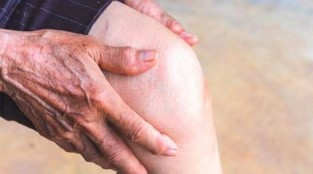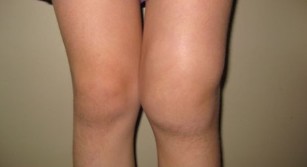Osteoarthritis of the knee (gonarthrosis) is a disease characterized by degenerative diseases and degenerative changes of the cartilage, menisci, and bones that form the knee joint. The disease takes the leading place among the diseases of the musculoskeletal system.

Causes gonartrosia
Osteoarthritis of the knee is polyetiological disease, that is, in this state, when the development of pathological changes contribute different causal factors. In this case, speak of primary (idiopathic) osteoarthritis. When the secondary gonartrosie a precise factor which has caused the disease.
The main reasons for the arthritis are:
- a knee injury;
- surgical interventions in the area of the knee;
- greater physical effort;
- overweight, obesity;
- a congenital disorder of the lower limbs;
- the syndrome of system connective tissue dysplasia;
- disorders of the metabolism;
- common diseases (diabetes, rheumatoid arthritis, the acromegaly).
Important!
The impact of posttraumatic agent is the main cause of osteoarthritis in young age. Injuries of the knee, leading to osteoarthritis, are sprains, fractures, or damage to the meniscus.
The basis for the development of pathological changes is the need of joint mobilization after injury, this contributes to worsen blood circulation in periarticular tissues, which, together with the mechanical damage due to long healing and the development of signs of osteoarthritis.
Greater physical effort is manifested not only in an intense exercise, but also in the presence of excess weight. Excess weight and exercise, not adapted to their age and level of physical form of a person, lead to the emergence of micro-fractures in the cartilage or menisci, that is the first step in a process of training gonartrosia.
A congenital disorder of the lower limbs, which refer to shortening of a limb, dysplasia, and even of the big toe valgus or varus deformity of the foot causes the onset of osteoarthritis due to the uneven distribution of the weight of a person. In consequence of this, detach the cartilage, is formed by an outbreak of inflammation, aseptic, with the appearance of characteristic clinical symptoms of osteoarthritis.
The syndrome of system connective tissue characterized by dysplasia, hyper-mobility and insufficiency of the ligaments of the machine. Bringing in the shoulder increases the amplitude of the movements, up to the pathological. This instability quickly leads to the birth of minor injuries the menisci and articular surfaces of cartilage.
Disorders of the metabolism and presence in general-pathology-somatic causes for the development of osteoarthritis due to disturbances of the microcirculation in the knee, the food, the deterioration of the cartilage and menisci, the deterioration of the composition of the synovial fluid.
Classification
The ICD-10 code – M17. Depending on the causative factor, promotes the formation of osteoarthritis, distinguish the following categories:
- M17.0 – primary gonarthrosis two-way;
- M17.1 – a other primary gonarthrosis;
- M17.2 – disorder post-traumatic knee osteoarthritis in two ways.
- M17.3 – other post-traumatic gonarthrosis;
- M17.4 – other secondary gonarthrosis, bilateral;
- M17.5 – other secondary gonarthrosis;
- M17.9 – osteoarthritis osteoarthritis not refined.

Distinguish the following types of osteoarthritis of the knee:
- involution – occurs because of age-related changes of the body, disorders of the metabolic processes, the wear and tear of the articular surfaces of the bones;
- dysplastic – is associated with congenital anomalies of the lower limbs;
- post-traumatic;
- metabolic – occurs when common diseases accompanied by metabolic disorders (gout, chondrocalcinosis);
- dishormonal – occurs when hormonal imbalance in the body for diabetes, menopause, disorders functioning thyroid;
- after-inflammatory – occurs after infectious and inflammatory diseases of the knee joint;
- static – occurs with excessive physical exertion, the correct distribution of weight, obesity;
- ischemic – is associated with circulatory disorders patella field.
The pathogenesis
The disease develops gradually. First of all, the changes appear in Podhradie level of the micro-cracks. Microfractures caused a constant work of the knee, one of the functions that the cushioning shock when you walk. And in the presence of the etiological factors load on the knee increases even more, and the processes of destruction begin to overcome the processes of the recovery of cartilage tissue, causing cracks.
Subsequently, micro-fractures penetrates the synovial fluid, and form cysts, which tend to increase and the merger. Large cysts begin to compress the blood vessels that nourish the cartilage, with consequent deficiency of oxygen starvation of the cartilage tissue. Disorders of the metabolism, impairs the synthesis of collagen, necessary for restoration of cartilage. Considering the bad repair of the cartilage, occurs gradual thinning, which leads to the rupture of the joint function, appear the clinical signs of the disease.
Note!
With the progression begin to form osteophytes – bony growth. Osteophytes predominantly located at the edges of the articular surfaces of the bones. Their presence causes the expressed inflammatory response in the knee, the pain, the deformation of the joint, a considerable limitation of mobility.
With the development of the inflammatory process observed tissue edema, leading to an increase of pressure within the joint, the deterioration of the composition of the synovial fluid, the broken, the nutrition of the cartilage.
The clinical symptoms
During the disease are different degrees of osteoarthritis, which reflect the process of progression of pathological changes and have some clinical manifestations.
The symptoms of osteoarthritis of the knee is divided into the phase of:
- The initial phase of the disease is characterized by the appearance of pain in the knee area, especially after strenuous exercise or in the event of a prolonged stay in the foot. Less favorable static load, i.e. lifting weights. Knee pain goes only after the rest. In addition, the pain can appear crunching or ticking noise in the joint, which testifies to the violation of the congruence of the articular surfaces of the bones that form the joint and the appearance of micro-fractures in the cartilage. The lack drastically expressed clinical signs leads to the fact that the majority of patients turn to a doctor in the initial phase, which leads to the diagnosis recently.
- The progression of the disease leads to the formation of a more marked pain syndrome – the pain occurs after even a minor load, by only not pass. Appears morning stiffness in his joints, lasting about 30 minutes, but if it joins the inflammation, then the stiffness can last up to 1 hour. Because of a severe pain the man begins to save the leg, decreases the amplitude of the movements, appears to be lameness. Because of an edema in the knee, increases the volume. Appear radiographic signs of osteoarthritis of the knee.
- The appearance of osteophytes characterizes the development 3 stage of the disease, in which is expressed a strong pain even at rest, the evil jugulate drugs. The traffic is practically absent, the joint is deformed. Perhaps jamming the knee into a particular position, and dislocations or subluxations of the vertebrae.

Diagnostic exam
The diagnosis of osteoarthritis is made up of several components:
- The complaint of the patient.
- The history of the development of the disease.
- Life history of the patient.
- Laboratory and instrumental methods of research.
On the basis of complaints the patient, but also the history of life and of the disease, the doctor exposes the preliminary diagnosis. But for the differential diagnosis with other diseases and to establish an accurate diagnosis is necessary to the conduct of laboratory and instrumental methods.
The instrumental methods of investigation of the knee are:
- x-ray;
- arthroscopy;
- computed tomography;
- ultrasound;
- tomography, magnetic resonance imaging.
Important!
The main instrument for the diagnosis of osteoarthritis is an x-ray examination. X-ray of the knee is done in two projections, which gives a complete picture of the changes. It is important to note that in the initial stages of osteoarthritis in the picture is not detected.
On the basis of the identified signs, and radiological construction x-ray classification gonartrosia:
- 1 degree – mild reduction of the joint space;
- 2 degree – mild reduction of the joint space, the presence of bone marrow gaskets;
- 3 grade – marked reduction of the joint space, presence of osteophytes, initial signs of bone deformity;
- 4 – marked reduction of the joint space up to its full absence, numerous osteophytes, and destruction of bone tissue, the deformation of the joint.
The other methods of investigation of the knee are in addition to the main x-ray research. And held as additional diagnostics in case of difficulty in diagnosis.
Each of the methods of diagnosis has its indications, contraindications and cost is different, then necessarily must be assigned to a specialist if necessary.
How to treat osteoarthritis of the knee
The treatment of osteoarthritis of the knee, you need to start when the first clinical symptoms of the disease. The modern treatment of osteoarthritis of the knee is aimed at the recovery of the joint function and improve the quality of life of patients and is the following:
- the termination or reduction of the pain;
- the treatment of the inflammatory process;
- the recovery of the structure of the cartilage;
- an increase of the amplitude of the movements;
- improve the microcirculation of the periarticular tissues.

Note! It is important to note that in the various phases that are used different methods of treatment. If the time to start fighting with the disease, it is possible to eliminate not only pain, but also to reconstruct the knee joint during osteoarthritis, but also to prevent the onset of complications.
Applied drug therapy helps to reduce pain and the inflammatory response, this being obtained through the application of nonsteroidal anti-inflammatory drugs. For the recovery of the cartilage are assigned chondroprotector. The diagram of treatment assigned and monitored by a physician.
In addition to medical care are assigned physiotherapy, ointments, exercise, massage, or intra-articular injections of drugs.
That treat osteoarthritis of the knee
In this case, it is possible to receive the jelly, which can be taken orally or make a compress. The traditional medicine must not be administered as monotherapy and to be part of a complex of therapeutic measures. Before starting a similar treatment in your home, you need to be familiar with the recommendations and reviews.
And ' possible to cure osteoarthritis
The incorrect or delayed treatment of the consequences of the progression of the disease will not make you wait. Osteoarthritis osteoarthritis is dangerous, because the right treatment can completely stop the process, and only interferes, but allows the man a longer time to save the task.
If the disease has come to severe the initial stage, conservative treatment becomes inefficient. During phase 3, they pass on the surgical treatment, after which it is necessary a long rehabilitation.




























